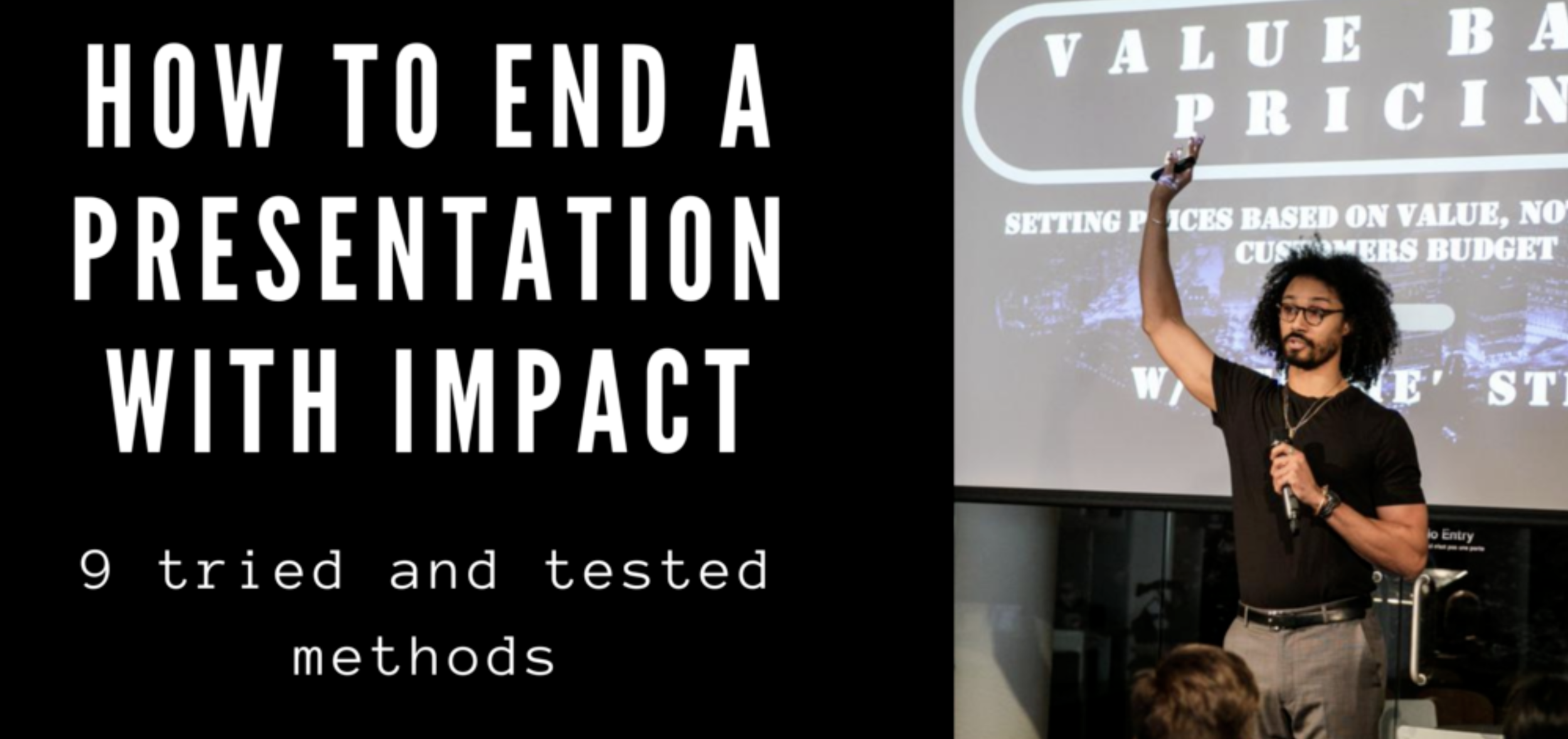How to end a presentation with impact: 9 tried and tested methods
The beginning and end of your presentation can make or break how it’s received. At the start of your presentation, you need to make sure you build interest and get people hooked in. The end of a presentation is for making a final lasting impression and getting your audience to take action.
But ending your presentation abruptly will guarantee that your audience forgets most of your presentation before they even walk out the door.
I know, after a long presentation you might feel like disappearing for a cold beer or a nap. Hold off on the Houdini act for a minute and hear me out.
I’ve made this guide on how to end your presentation for maximum impact that’ll leave your audience thinking about your presentation for the rest of the day!
Read on for the 9 best ways to end a presentation for a lasting impression.
1 - Use facts and statistics
Surprising facts or shocking statistics are like candy to your audience. Even towards the end of a long presentation, an impactful statistic can get people right back to giving you their undivided attention before you exit the stage.
If you know your presentation topic well, you’ll probably already have a few cool facts under your belt. If you need more, head to google and get researching! You should ideally have a handful of highly impactful, controversial, or unexpected facts and statistics to keep people dialed in through to the end of your presentation.
2 - Link back to your introduction
This is one of the oldest tricks in the book and is well known as an effective way to end a presentation. Comedians often tie their whole stand-up routine together by linking the end of their routine to something they said at the beginning.
You can do the same when presenting, and your audience will love you for it.
This creates a feeling of closure or even familiarity for your audience and shows them that your talk is coming to a natural end.
But how do you tie the beginning and end of a presentation together? Here are some common methods:
Ask a question at the beginning of your speech and only answer it at the end of your presentation.
Title your presentation with a strong statement and end your presentation on that statement. Finish a story you started, using the anecdote to demonstrate your message
Start your presentation off with an anecdote and finish telling the anecdote at the end of the presentation.
3 - Use the rule of three
Presenting information in patterns makes it easier to emphasize important points. The rule of three is a simple yet powerful method of communication and we often use it in everyday life without realizing it. Presenting information in patterns of three also makes it much more memorable for the audience.
The rule of three is basically repeating certain keywords in a pattern of three. Using this at the end of your presentation will help you stick that last thought in your audience’s mind and go out on a memorable tone.
Here’s a famous example of the rule of three being applied by Steve Jobs in his Stanford commencement speech:
“It means to try to tell your kids everything you thought you’d have the next 10 years to tell them in just a few months. It means to make sure everything is buttoned up so that it will be as easy as possible for your family. It means to say your goodbyes.”
4 - Show gratitude
When your presentation is a result of a team effort, or you had help from others in researching and planning your presentation, it’s a good idea to thank them at the end.
This is mostly just good manners, but it also gives your audience more insight into the whole process behind your presentation and makes things more transparent.
It can also be beneficial to thank your audience, depending on the context. When your audience sat through a long technical presentation, or when you’re trying to get them to take action immediately afterward, giving them a brief but sincere thanks can go a long way.
5 - Use memorable visuals
A striking visual in your last presentation slide is key in making your audience remember you and your message.
This could be anything from an interesting picture of your product to a hard-hitting quote on a visually impressive background.
Pro tip: Leave this slide up for a few minutes so that it’s burned into your audience’s subconscious as the presentation comes to a close.
6 - Tell stories
Everybody loves a good story. Why? Because it’s personal, and it helps us relate to others.
Try ending your presentation with a short anecdote or story that emphasizes your take-home points. Aim to make it something that will resonate with your audience and their own experiences. Empathizing with them goes a long way in solidifying the rapport that you’ve built up during the rest of the presentation.
If you don’t have any completely authentic stories that you can incorporate into the end of your presentation, you could get a little creative and adapt a different story so that it fits your narrative. Don’t get too creative though. Keep the unicorn and alien stories to yourself for now.
7 -Use impactful quotes
Audiences love hearing quotes from experts, historical figures, or famous people, so this is another great way to get their attention and make a lasting impact towards the end of your presentation.
Don’t just throw any old quote in, and make sure it’s not one of those tired old quotes that we’ve all heard a million times. You know, the “Today is the first day of the rest of your life” kind.
Quotes should be relevant to your presentation topic and should provoke some kind of emotional response with your audience. If it’s a long or complicated quote, feel free to add your own take on it so that the audience understands it completely.
8 - Focus on your main message
At the end of your presentation, quickly touch on your main points if necessary. This just refreshes your key ideas and helps them keep everything at the very front of your audience’s mind.
If your presentation is supposed to come to some kind of big reveal or striking conclusion, make sure you dedicate enough time for your audience to process this. Ending things abruptly immediately after presenting your main conclusion will leave your audience shell shocked and unable to take it all in their own time.
9 - Give a clear CTA
A good Call To Action (CTA) is vital if you want your audience to take some kind of action (duh!) after you’ve finished talking.
CTAs should make the audience feel like there’s something in it for them if they take action. Provide value, and people will take action. It’s that simple!
Here’s an example of a good CTA:
You want your audience to buy a product: “Visit our website at www.BestProductEver.com in the next hour and you’ll get 15% off this product as a thank you for listening to my presentation today”.
Final thoughts
So, you now have a pretty good idea on how to end a presentation with impact.
The main takeaway? Be memorable and provide value.
If you can disrupt people’s thought patterns with something unusual, memorable, highly valuable, and relevant to their lives, then you’ve nailed the end of your presentation.
Not sure how to start your presentation either? Read all about how to hook your audience from the get-go.
What do you think?
Not everybody presents in the same way. The way I do things work wonders for my clients and students, but I’m always open to new ideas.
What’s your favorite way of ending a presentation? Let me know in the comments below or drop me an email and we can exchange ideas.
Happy presenting!







